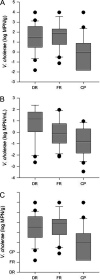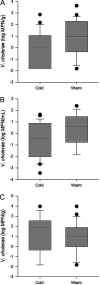Environmental Drivers of Vibrio cholerae Abundances in Mobile Bay, Alabama
- PMID: 36692305
- PMCID: PMC9927273
- DOI: 10.1128/spectrum.01733-22
Environmental Drivers of Vibrio cholerae Abundances in Mobile Bay, Alabama
Abstract
Vibrio cholerae is the etiological agent of the illness cholera. However, there are non-O1/non-O139 V. cholerae (NOVC) strains that generally lack the toxin gene (ctx) and colonization factors that cause cholera. These NOVC strains are autochthonous members of estuarine environments and a significant cause of seafood-borne gastroenteritis in the United States. The objective of this study was to identify environmental parameters that correlate with NOVC prevalence in oysters, water, and sediment at three ecologically diverse locations in Mobile Bay, AL, including Dog River (DR), Fowl River (FR), and Cedar Point (CP). Oyster, water, and sediment samples were collected twice a month when conditions were favorable for NOVC growth and once a month when they were not. A most probable number (MPN)/real-time PCR assay was used to determine NOVC abundances. Environmental parameters were measured during sampling to determine their relationship, if any, with NOVC at each site. NOVC abundances in oysters at DR, FR, and CP were 0.87, 0.87, and -0.13 log MPN/g, respectively. In water, the median NOVC levels at DR, FR, and CP were 1.18, -0.13, and -0.82 log MPN/mL, and in sediment, the levels were 1.48, 1.87, and -0.03 log MPN/g, respectively. Correlations of NOVC abundances in oyster, water, and sediment samples with environmental parameters were largely site specific. For example, the levels of NOVC in oysters at DR had a positive correlation with temperature but a negative correlation with dissolved oxygen (DO) and nutrient concentrations, NO2-, NO3-, dissolved inorganic nitrogen (DIN), total dissolved nitrogen (TDN), and dissolved inorganic phosphorus (DIP). At FR, however, the levels of NOVC in oysters displayed only a negative correlation with NO2-. When grouping NOVC abundances by temperature, the main driving factor for prevalence, additional correlations with salinity, total cell counts, dissolved organic nitrogen (DON), and dissolved organic carbon (DOC) became evident regardless of the site. IMPORTANCE NOVC can cause gastrointestinal illness in humans, which typically occurs after the consumption of raw or undercooked seafood. Incidence rates of NOVC gastroenteritis have increased during the past decade. In this study, NOVC was enumerated from oysters, sediment, and water collected at three sites in Mobile Bay, with environmental parameters measured concurrently over the course of a year, to identify potential environmental drivers of NOVC abundances. The data from this study, from an area lacking in V. cholerae research, provide a useful baseline for risk analysis of V. cholerae infections. Defining correlations between NOVC and environmental attributes at different sites and temperatures within a dynamic system such as Mobile Bay provides valuable data to better understand the occurrence and proliferation of V. cholerae in the environment.
Keywords: Mobile Bay; NOVC; V. cholerae non-O1/O139; ompW; seasonality.
Conflict of interest statement
The authors declare no conflict of interest.
Figures




Similar articles
-
Heterogeneous Growth Enhancement of Vibrio cholerae in the Presence of Different Phytoplankton Species.Appl Environ Microbiol. 2022 Sep 13;88(17):e0115822. doi: 10.1128/aem.01158-22. Epub 2022 Aug 24. Appl Environ Microbiol. 2022. PMID: 36000870 Free PMC article.
-
Clinical and Environmental Vibrio cholerae Non-O1, Non-O139 Strains from Australia Have Similar Virulence and Antimicrobial Resistance Gene Profiles.Microbiol Spectr. 2023 Feb 14;11(1):e0263122. doi: 10.1128/spectrum.02631-22. Epub 2023 Jan 23. Microbiol Spectr. 2023. PMID: 36688638 Free PMC article.
-
Toxigenic Vibrio cholerae strains in South-East Queensland, Australian river waterways.Appl Environ Microbiol. 2023 Oct 31;89(10):e0047223. doi: 10.1128/aem.00472-23. Epub 2023 Oct 6. Appl Environ Microbiol. 2023. PMID: 37800954 Free PMC article.
-
Global emergence of environmental non-O1/O139 Vibrio cholerae infections linked with climate change: a neglected research field?Environ Microbiol. 2020 Oct;22(10):4342-4355. doi: 10.1111/1462-2920.15040. Epub 2020 May 15. Environ Microbiol. 2020. PMID: 32337781 Review.
-
Non-O1/non-O139 Vibrio cholerae bacteraemia in mainland China from 2005 to 2019: clinical, epidemiological and genetic characteristics.Epidemiol Infect. 2020 Jul 8;148:e186. doi: 10.1017/S0950268820001545. Epidemiol Infect. 2020. PMID: 32635946 Free PMC article. Review.
Cited by
-
Does climate change increase the risk of marine toxins? Insights from changing seawater conditions.Arch Toxicol. 2024 Sep;98(9):2743-2762. doi: 10.1007/s00204-024-03784-5. Epub 2024 May 25. Arch Toxicol. 2024. PMID: 38795135 Review.
-
Tracking Vibrio: population dynamics and ecology of Vibrio parahaemolyticus and V. vulnificus in an Alabama estuary.Microbiol Spectr. 2024 May 2;12(5):e0367423. doi: 10.1128/spectrum.03674-23. Epub 2024 Apr 5. Microbiol Spectr. 2024. PMID: 38578091 Free PMC article.
References
-
- Centers for Disease Control and Prevention. 2020. Non-cholera Vibrio cholerae infection. Centers for Disease Control and Prevention, Atlanta, GA. https://www.cdc.gov/cholera/index.html.
-
- Awasthi SP, Chowdhury N, Neogi SB, Hinenoya A, Hatanaka N, Chowdhury G, Ramamurthy T, Yamasaki S. 2019. Development of a multiplex PCR assay for the detection of major virulence genes in Vibrio cholerae including non-O1 and non-O139 serogroups. J Microbiol Methods 157:54–58. doi: 10.1016/j.mimet.2018.12.012. - DOI - PubMed
MeSH terms
Substances
LinkOut - more resources
Full Text Sources
Medical
Miscellaneous

